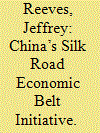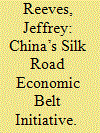| Srl | Item |
| 1 |
ID:
159910


|
|
|
|
|
| Summary/Abstract |
This article demonstrates that, rather than constituting a new model for Central Asian international relations, the SREB’s real strategic value for China is as an organizational concept and as an influence multiplier. In recasting its Central Asian bilateral relations as part of the SREB engagement model, Beijing has overlaid a strategic-level concept to its otherwise disparate patterns of engagement. In so doing, the Xi administration has consolidated its multiple lines of efforts and the diverse Chinese-based actors—both state and private—into a grand narrative: one that serves the strategic purpose of integration. The Xi administration has used (and is using) this integration to expand its influence throughout the Central Asian region, both through its bilateral relations and through a SREB-resulting network of Central Asian states. In particular, one sees regular instances within China’s SREB engagement where the Xi administration uses the initiative to reconstitute regional states’ development priorities, interests and relations in ways that benefit China’s overall strategic interests.
|
|
|
|
|
|
|
|
|
|
|
|
|
|
|
|
| 2 |
ID:
159911


|
|
|
|
|
| Summary/Abstract |
This article demonstrates that, rather than constituting a new model for Central Asian international relations, the SREB’s real strategic value for China is as an organizational concept and as an influence multiplier. In recasting its Central Asian bilateral relations as part of the SREB engagement model, Beijing has overlaid a strategic-level concept to its otherwise disparate patterns of engagement. In so doing, the Xi administration has consolidated its multiple lines of efforts and the diverse Chinese-based actors—both state and private—into a grand narrative: one that serves the strategic purpose of integration. The Xi administration has used (and is using) this integration to expand its influence throughout the Central Asian region, both through its bilateral relations and through a SREB-resulting network of Central Asian states. In particular, one sees regular instances within China’s SREB engagement where the Xi administration uses the initiative to reconstitute regional states’ development priorities, interests and relations in ways that benefit China’s overall strategic interests.
|
|
|
|
|
|
|
|
|
|
|
|
|
|
|
|
| 3 |
ID:
141939


|
|
|
|
|
| Summary/Abstract |
BY THE EARLY TWENTY-FIRST CENTURY, the United States and China found themselves strategically and economically interconnected at the global level with elements of military-political rivalry. Chinese diplomacy carefully avoided direct confrontation with America on the world arena,1 that probably meant that Beijing was biding its time to multiply its political might (very much in line with Deng Xiaoping's taoguang yanghui tactics - "conceal our capabilities, avoid the limelight"). Much of what China is doing - building up its military budget, undertaking military modernization, seeking access to natural resources outside its territory, etc. - was interpreted as a movement in this direction.
|
|
|
|
|
|
|
|
|
|
|
|
|
|
|
|
| 4 |
ID:
141015


|
|
|
|
|
| Summary/Abstract |
In May 2015, the leaders of the Russian Federation and the People's Republic of China adopted a joint statement on the integration of the Eurasian Economic Union (EEU) and the Silk Road Economic Belt initiative. The integration of the two largest Eurasian projects will create new conditions for the social and economic development of all participating countries.
|
|
|
|
|
|
|
|
|
|
|
|
|
|
|
|